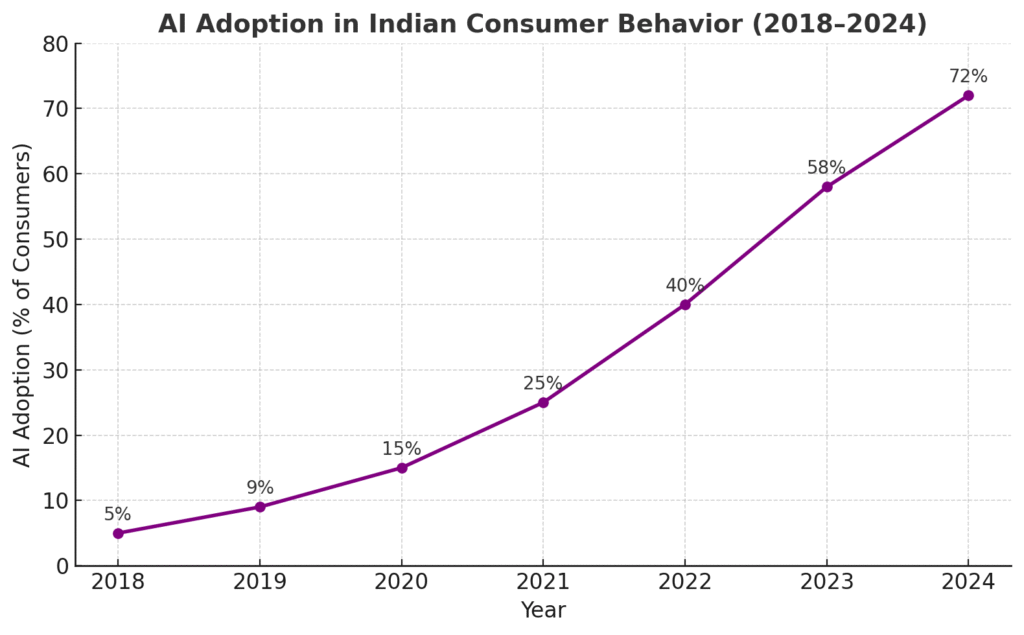Table Of Content
Artificial Intelligence (AI) has become the buzzword of our era, promising to reshape how Indians work, shop, learn, and even think. From UPI fraud detection alerts to Flipkart’s personalized shopping suggestions, AI is quietly shaping millions of daily choices.
But here’s the question nobody is asking: is AI in Indian consumer behavior truly empowering smarter decision-making—or simply making people more dependent on algorithms?
India is among the top three countries in AI adoption, according to NASSCOM. Yet the story isn’t straightforward. On one hand, AI helps consumers discover better products, save money, and access healthcare. On the other, it risks turning consumers into passive recipients of machine-driven nudges.
At Webverbal, we believe it’s time to interrogate this duality. AI may be India’s biggest consumer revolution—but is it a liberation, or a subtle dependency trap?
The Rise of AI in Indian Consumer Behavior

AI is no longer confined to labs or corporate back offices. It’s embedded in the apps and platforms Indian consumers use daily:
- E-commerce: Flipkart and Amazon recommend products tailored to browsing history.
- Food delivery: Swiggy and Zomato use AI to push “trending” meals or surge pricing.
- Mobility: Ola and Uber use algorithms for dynamic fares.
- Finance: Paytm uses AI to detect fraudulent transactions.
- Customer service: AI-powered chatbots dominate banks, airlines, and telcos.
According to McKinsey, India’s AI adoption is accelerating faster than many developed markets. Consumers interact with AI systems hundreds of times a week—often without realizing it.
This raises the pulse question: is this transformation making Indian consumers smarter—or quietly shaping their choices?
(See our piece on Quick Commerce in India to explore how AI-driven recommendations are changing shopping habits.)
How AI Is Making Indian Consumers Smarter
There’s no denying the benefits of AI in Indian consumer behavior.
a. Personalization for better shopping
AI helps consumers cut through overwhelming product catalogs. Flipkart’s recommendation engine saves time and surfaces relevant options, making shopping more efficient.
b. Financial literacy support
Neo-banks and fintech startups use AI to provide nudges: “Spend less this week” or “Here’s a cheaper mutual fund option.” For many first-time investors, AI becomes a teacher.
c. Healthcare access
AI-powered telemedicine apps like 1mg or Practo offer early diagnosis, medicine reminders, and affordable consultations—bridging access gaps in smaller towns.
d. Education and skills
Adaptive learning platforms like BYJU’s or Vedantu deploy AI tutors that adjust lessons based on individual progress. For students in Tier-2/3 cities, this can mimic personalized coaching otherwise unavailable.
In these cases, AI isn’t replacing human judgment—it’s augmenting consumer intelligence.
The Dependency Problem: Are Consumers Losing Agency?
But there’s a flip side. AI systems don’t just inform—they influence.
a. Filter bubbles and limited choice
OTT platforms like Netflix or Hotstar use algorithms to recommend shows. Consumers often end up watching what AI suggests rather than actively searching. Over time, curiosity narrows.
b. Decision outsourcing
From shopping to dining, consumers increasingly “let AI decide.” Instead of evaluating alternatives, they trust algorithms blindly. This reduces independent thinking.
c. Privacy trade-offs
Dependence on AI means surrendering vast amounts of personal data. Every recommendation is powered by surveillance. Most consumers have no visibility into how their data is used.
d. Critical thinking at risk
When students use ChatGPT for assignments, or professionals let AI draft emails, convenience can erode creativity and effort. The risk: consumers stop questioning, analyzing, or experimenting.
As Brookings points out, AI can create “dependency loops”—where consumers repeatedly rely on automated suggestions, eventually losing the habit of self-driven choices.
This is where the promise of smarter consumers collides with the danger of dependence.
Contrarian View: The Indian Context
Here’s where India’s story diverges from the West.
Most Indian consumers are first-time digital adopters. For someone in Bharat using UPI for the first time, AI-driven fraud detection isn’t dependence—it’s protection. For a farmer checking mandi prices on a smartphone, an AI-powered app is empowerment.
Yet, the danger is that India might leapfrog directly into dependency. Without strong digital literacy foundations, consumers may rely on AI too quickly—before developing healthy skepticism.
This is why the Digital India narrative inclusion debate matters (read here). Inclusion is not just about access—it’s about ensuring consumers understand the tools they use. Otherwise, AI risks widening the literacy gap.
What Balance Between Smartness and Dependency Looks Like
So, how can India ensure that AI builds smartness, not dependence?
AI as assistant, not decision-maker
AI should suggest, not dictate. Consumers must remain in control of final decisions.
Demand for transparency
Why was a product recommended? Why is a loan rejected? Consumers need “explainable AI” to build trust.
Policy guardrails
Regulators like RBI and MeitY must enforce consumer-centric AI ethics: fairness, privacy, and accountability.
AI literacy as the next frontier
India needs mass campaigns to teach consumers how AI works, its benefits, and its risks—similar to financial literacy campaigns.
Entrepreneurial responsibility
Founders building AI-powered apps must design with empathy. Is your AI creating convenience—or dependence?
Only with this balance can AI in Indian consumer behavior become a tool for empowerment rather than a crutch.
Conclusion & Webverbal’s Pulse
AI in India is not just a technology—it’s a cultural shift. It is changing how consumers think, decide, and act.
Our contrarian pulse is this: AI is making Indian consumers smarter—and more dependent, at the same time. The duality is real. The future depends on which side we nurture.
If India builds literacy, transparency, and balance, AI can democratize smartness for millions. If not, AI may quietly script consumer dependency at a national scale.
At Webverbal, we’ll continue to ask the tough questions. Because AI isn’t just reshaping the future of business—it’s reshaping the consumer mind itself.
That’s the pulse. What’s yours?
FAQs
AI is transforming how Indian consumers shop, pay, learn, and access healthcare. It personalizes experiences but also risks creating dependence.
By offering personalized shopping, financial literacy nudges, healthcare access, and adaptive education tools that empower better decision-making.
Yes, over-reliance on recommendations, pricing algorithms, and AI-driven decisions can reduce independent thinking and agency.
Risks include privacy trade-offs, loss of critical thinking, filter bubbles, and reduced consumer choice.
Through AI literacy, transparency in algorithms, responsible AI policies, and consumer-first product design.




